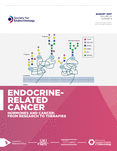Genetics of primary hyperaldosteronism
- 1Department of Clinical and Experimental Medicine, Medical Faculty, Linköping University, Linköping, Sweden
- 2Department of Surgery, County Council of Östergötland, Department of Clinical and Experimental Medicine, Medical Faculty, Linköping University, Linköping, Sweden
- Correspondence should be addressed to O Gimm; Email: oliver.gimm{at}liu.se
Abstract
Hypertension is a common medical condition and affects approximately 20% of the population in developed countries. Primary aldosteronism is the most common form of secondary hypertension and affects 8–13% of patients with hypertension. The two most common causes of primary aldosteronism are aldosterone-producing adenoma and bilateral adrenal hyperplasia. Familial hyperaldosteronism types I, II and III are the known genetic syndromes, in which both adrenal glands produce excessive amounts of aldosterone. However, only a minority of patients with primary aldosteronism have one of these syndromes. Several novel susceptibility genes have been found to be mutated in aldosterone-producing adenomas: KCNJ5, ATP1A1, ATP2B3, CTNNB1, CACNA1D, CACNA1H and ARMC5. This review describes the genes currently known to be responsible for primary aldosteronism, discusses the origin of aldosterone-producing adenomas and considers the future clinical implications based on these novel insights.
- Received 8 July 2016
- Accepted 1 August 2016
- Made available online as an Accepted Preprint 2 August 2016
- © 2016 Society for Endocrinology












